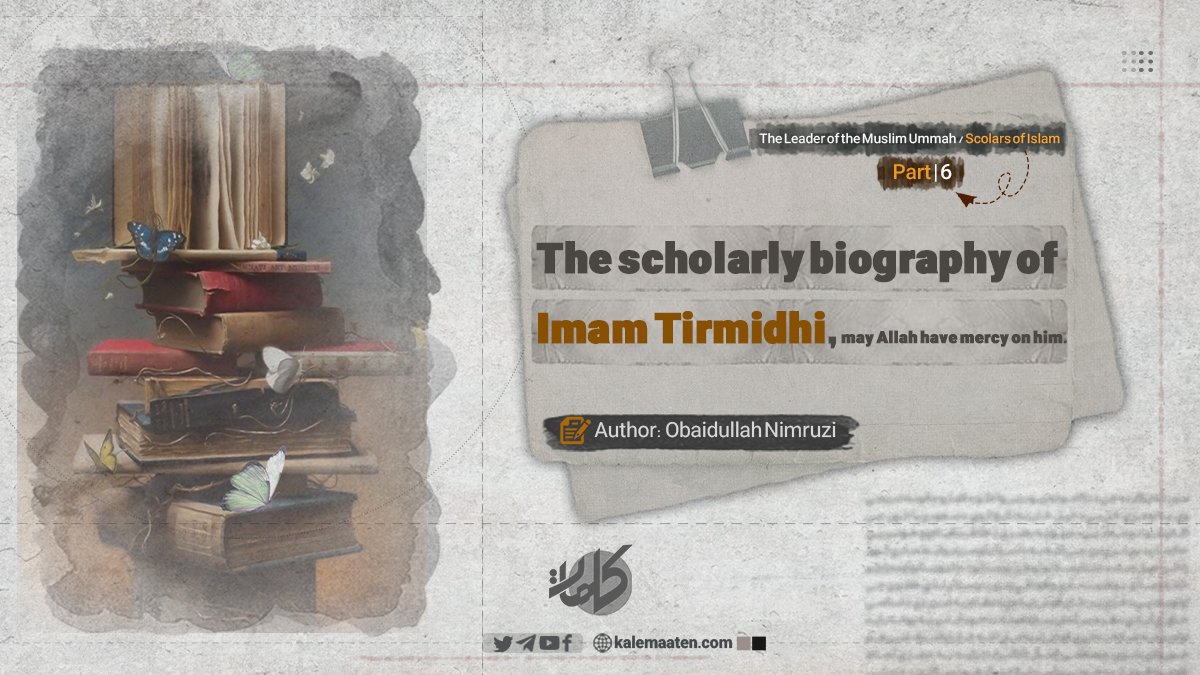
Author: Obaidullah Nimruzi
The Scholarly Biography of Imam Tirmidhi ‘May Allah Have Mercy on Him’ (Part 6)
Method of Citing Hadiths Indicating the Translation of the Chapter
Imam Tirmidhi employed two primary methods in citing hadiths related to each chapter:
A: Narrating a Collection of Hadiths with Chains of Transmission
In this method, Imam Tirmidhi first presents a hadith with its text and complete chain of transmission and then continues to cite other hadiths in a similar manner. This method is implemented in Jami’ al-Tirmidhi in four distinct ways:
1. Narrating Authentic Hadiths from Different Sahaba: Imam Tirmidhi first narrates authentic hadith from one Sahabi, followed by similar content from other Sahaba. For example, in the chapter on the middle prayer, he first narrates the hadith from Abu Yunus, the servant of Hazrat Ayesha (may Allah be pleased with her), and then provides other supporting hadiths from different Sahaba.
He states, “On the authority of Abu Yunus… ‘Ayesha ordered me to write a Quran for her, and she said: When you reach this verse, tell me:«حافظوا علی الصلوات والصلوة الوسطی» “Maintain the prayers and the middle prayer.” When I reached it, I told her, and she ordered: ‘Maintain the prayers and the middle prayer and stand in submission to Allah.’ She said: I heard it from the Messenger of Allah (peace and blessings of Allah be upon him).”
Imam Tirmidhi remarks, “This is a Hasan sahih hadith.” He follows this by narrating another hadith from Hazrat Samurah ibn Jundab, then from Hazrat Ali, and so on, concluding with the statement that these are all Hasan sahih hadiths.
2. Narrating Weak Hadiths after a Sahih Hadith: Sometimes, Imam Tirmidhi presents a sahih hadith first and then follows it with one or more weak hadiths. His intent is to demonstrate the multiplicity of hadith sources while strengthening the first hadith. For instance, in the chapter regarding the ten days, he relates from Ibn Abbas (may Allah be pleased with him): “The Messenger of Allah (peace and blessings of Allah be upon him) said: There are no days of righteous action that are more beloved to Allah… Hadith.” He adds, “The hadith of Ibn Abbas is a Hasan sahih hadith, strange hadith.” He then narrates similar hadith from Abu Hurairah and notes: “A strange hadith that we do not know except from the hadith of Masoud ibn Wasil from al-Nihas.”
Here, Imam Tirmidhi aims to highlight the diversity of hadith sources.
3. Narrating Strong Hadiths after Weak Hadiths: In some instances, Imam Tirmidhi first mentions a weak hadith, followed by stronger and more authentic hadiths. His goal is to show the weakness of the initial hadith while reinforcing the existence of stronger sources. For example, in the chapter regarding “Whoever prays on the day and night of the twelfth of the year has no merit,” he first cites a hadith from Ayesha (may Allah be pleased with her): “The Messenger of Allah (peace and blessings of Allah be upon him) said: ‘Whoever perseveres in twelve raka’ats…’” He comments, “The hadith of Ayesha is strange hadith from this perspective.” He then presents a hadith from Anbasah ibn Abi Sufyan and concludes it as a Hasan sahih hadith.
4. Narrating Consecutive Weak Hadiths: Occasionally, Imam Tirmidhi presents several weak hadiths sequentially. In the chapter on zakat of cows, he first cites a hadith from Abdullah ibn Mas’ud: “The Prophet (peace and blessings of Allah be upon him) said regarding thirty cows…” He adds, “Indeed, Abu Ubaidah ibn Abdullah did not hear anything from his father.” Following this, he quotes another hadith from Sufyan, ultimately deeming it Hasan.
Dr. Nur al-Din Attar explains this method, stating, “Although these hadiths are weak, they have been elevated to the level of Hasan and others due to the multiplicity of their methods.”
B: Narrating a Hadith and Referring to Other Related Hadiths
One distinctive feature of Imam Tirmidhi, as compared to others among the six Sahih compilations, is that he sometimes narrates only one hadith in full, including its text and chain of transmission, while briefly referencing other related hadiths. For example, in the chapter on the toothbrush (Miswak), he first recounts the hadith of Abu Hurairah: “If it were not for the hardships of my nation, I would have ordered them to use the toothbrush at every prayer.” He then adds, “And in this chapter, from Abu Bakr al-Siddiq, Ali, Ayesha, Ibn Abbas, and others…”
In this approach, Imam Tirmidhi names the Sahaba from whom similar hadiths have been narrated without claiming that these hadiths are identical to the one cited in terms of text or chain of transmission. Dr. Nur al-Din Attar explains: “Imam Tirmidhi’s aim is to present hadiths that can be used to support this argument.”
Continues…


